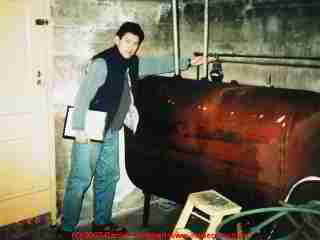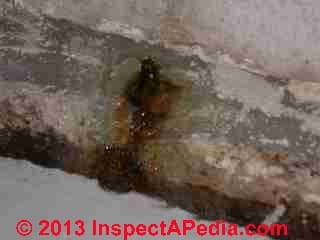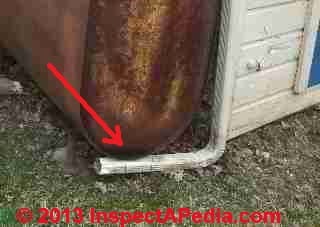 Oil Odors & Smells
Oil Odors & Smells
Odor sources traced to fuel oil, heating oil, oil storage tanks & oil piping leaks
Odor source diagnosis & repair - oil smells
- POST a QUESTION or COMMENT about how to diagnose & repair leaks at the oil tank fill or vent pipe
Sources of oil smells in or outside of buildings:
How to track down the source of an oil smell traced to fuel oil, heating oil, or even crude oil leaks from heating equipment, oil piping, or oil storage tanks. This article describes common sources of indoor or outdoor oil odors due to fuel oil, heating oil, or similar products.
A close look at the bottom of the outdoor above ground oil storage tank shown at page top shows what looks like oil seepage [click to enlarge]. We suspect this oil tank is leaking.
InspectAPedia tolerates no conflicts of interest. We have no relationship with advertisers, products, or services discussed at this website.
- Daniel Friedman, Publisher/Editor/Author - See WHO ARE WE?
Sources of Oil Smells Outdoors or Inside of Buildings
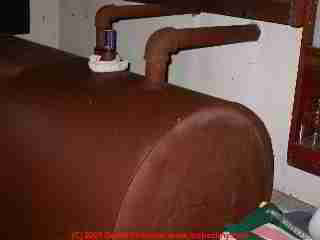 Here is a catalog of places to look when tracking down smells of diesel fuel, fuel oil, heating oil, or other oil products.
Here is a catalog of places to look when tracking down smells of diesel fuel, fuel oil, heating oil, or other oil products.
[Click to enlarge any image]
Heating or Fuel Oil Spills During Oil Storage Tank Fill-Up
While usually oil delivery drivers are quite careful, on occasion there may be some spillage around the fill of an oil storage tank occurring during tank fill procedures.
Look for oil stains on the ground around the fill or vent piping for both above ground fill and vent pipes and at the fill and vent pipes for buried oil tanks. If you see an oil spill contact your heating oil company to request cleanup help.
The reporting of fuel oil and heating oil spills of this nature may be required by federal or state laws.
Heating Oil Storage Tank Fill or Vent Pipe Leaks
It is very common for there to be leakage around the oil filler pipe or vent pipe where they are connected to the top of an oil tank. If the tank is buried these leaks may go undetected for some time, but on an above ground oil tank, inside or outside, the seepage is quickly visible and also can be smelled by most owners shortly after an oil delivery.
Details are
at OIL TANK FILL / VENT PIPE LEAK REPAIRS.
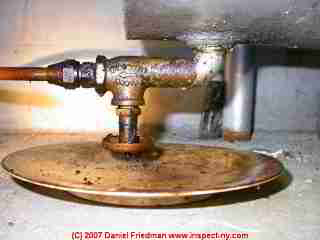 Usually an oil storage tank is filled right to its top during an oil delivery. This is because the way that the delivery driver knows that the tank is full is that s/he is (supposed to be) listening at the filler pipe.
Usually an oil storage tank is filled right to its top during an oil delivery. This is because the way that the delivery driver knows that the tank is full is that s/he is (supposed to be) listening at the filler pipe.
If the oil delivery driver is not listening to the tank whistle or tank alarm, or if the tank top fittings are not absolutely tight, it is common to see some leakage around the oil tank top after a fill-up.
See OIL TANK PRESSURES for an explanation of the stresses on oil tanks and piping during fill-up.
If you see oil on the floor, check the bottom of the tank, sides and welded seams,
and be sure to check the oil lines to the boiler and in particular, check the oil tank safety valve or other tank bottom fittings as
there are often leaks at these valves, as shown in this photograph.
Before addressing tank top filler pipe fittings as a leak source, make sure the oil leakage is from the top of the oil tank and not from a tank seam or tank rust perforation (check the tank bottom).
Make sure that you know where the seepage is coming from. There may be separate spillage outside at the filler pipe from that occurring inside at the tank top or other fill or vent pipe fittings.
Heating Oil Piping or Valve Leaks
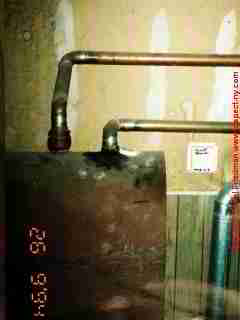
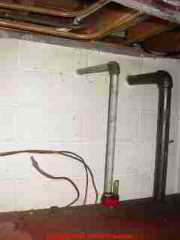
Make sure that the oil fill, vent, and fuel delivery piping is proper in material (steel is safer against rupture than plastic), and in diameter (2" or larger) for both vent and fill pipes.
The soldered copper fill and vent piping at the oil tank in the photo at above left
was unusual and may not be permitted. At the top of this page, the silver-colored (galvanized steel) oil tank vent pipe in the tank is probably too small for modern tank fill methods.
An older-installed small diameter vent or fill pipe [photo at above right] top risks over pressurizing the tank during fill-up, and risks a costly oil spill should an old tank or fill or vent line rupture. Ask your oil company to review the condition of the piping and the condition of the tank.
If the seepage is trivial in amount, say simply a light stain just a few inches around the tank top, clean it off and live with it. Or more properly, re-make the pipe joints when other plumbing work is planned. (It's quite a bit of trouble to re-make these joints, especially if the filler and vent piping have been routed through and cemented into a masonry wall.)
See OIL TANK PIPING & PIPING DEFECTS .
If the seepage is enough to wet the tank or run down the whole tank and drip onto the floor this is an
unacceptable condition that needs correction.
It's likely that the piping will have to be removed and (possibly new) piping installed.
I am doubtful that any "band-aid" approach like pushing epoxy putty or other sealers around the existing fitting is going to work. The surfaces will be rough, rusty, and oily.
If a reader or product manufacturer has a sealant that is actually effective in this application, dealing with the rust, oil, surface shapes, and fill pressure, I'll be glad to report on that product here.
It would indeed be less trouble than re-piping the tank. Make sure the new piping is properly sealed and secured.
If heating oil has been dripped on the floor, ask your oil company to clean it up and deodorize the area.
Actual Leaks in a Fuel Oil or Heating Oil Storage Tank
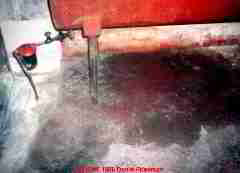 Leaks at an oil storage tank may not only produce a smell, but are likely to involve significant cost to clean up spilled oil if a significant leak occurs, especially a below-ground leak. We discuss leaky oil tanks beginning
Leaks at an oil storage tank may not only produce a smell, but are likely to involve significant cost to clean up spilled oil if a significant leak occurs, especially a below-ground leak. We discuss leaky oil tanks beginning
If an oil storage tank is leaking federal (and most state) laws require that the leak be reported to your local department of environmental conservation or environmental protection.
Actual heating oil spills:
If there is an actual oil spill, indoors or out, most state departments of environmental protection require that they be notified within 24 hours of the spill, an inspection is performed, and an expert specifies the amount of cleanup needed.
Leaks also occur or may have previously occurred at abandoned oil tanks in locations that can give off oil odors.
Our two photos above illustrate heating oil leaks seeping through the building foundation wall from an outside oil storage tank leak.
Because of the depth of the seepage points in the foundation wall (mid-wall at left, wall bottom at above right) and because there was no oil storage tank visible above ground at these locations, we suspected that a buried oil storage tank had previously leaked close to the foundation wall.
Further investigation was needed. Also
and OIL TANK LEAK POINTS.
Oil Odors Traced to Heating Equipment Malfunction
You may be smelling un-burned heating oil or fuel oil if the heating equipment is not working properly. A simple sniff test at the heating equipment may not be enough. Watch the equipment during start-up and shut down cycles, observing puffbacks, odd noises, or of course visual leaks around the equipment that occur during operation or when oil fired heating equipment is idle.
Keep in mind that in buildings heated or cooled by forced air, air ducts may transport odors from one building area to another.
See ODORS in AIR HANDLERS & DUCT WORK
Watch out: a mistake as simple as too little combustion air will produce a smoky flame and heating oil or fuel oil odors at and around oil fired heating equipment.
Oil Smells Traced to Nearby Diesel Fuel Stations, Automotive Repair Shops, or Diesel-Fueled Equipment
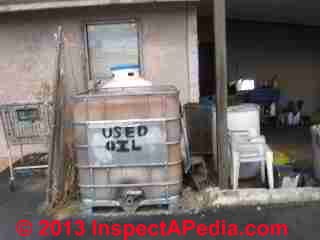 A nearby diesel fuel station or diesel fueled equipment may also be a source of fuel oil smells outdoors even if no actual leaks or spills are present.
A nearby diesel fuel station or diesel fueled equipment may also be a source of fuel oil smells outdoors even if no actual leaks or spills are present.
Our photo (left) shows a used oil collection tank that was not leaking at the time of our site visit. But at other automotive repair shops we occasionally see careless oil spills by workers or even by customers who drop off used oil for reclamation.
On occasion we observe diesel smells and even small leaks where diesel fueled equipment such as a backhoe or bulldozer is left parked.
Oil Smells Traced to Oil Pipelines or Piping
Oil odors may be traced to underground (or above ground) oil piping both from remote or curbside oil storage tank fill pipes used at some properties and even to oil pipelines that traverse properties.
In 2013 the New York Times reported that oil odors at a farm near Tioga, Colorado were traced to a small 1/4" sized leak in an oil pipeline crossing the property.
While oil companies monitor pipelines for evidence of leakage and are expected to respond promptly to any leak, some pipeline sections are not required to have oil leak monitoring nor pressure sensors sufficient to detect small leaks. In cases such as the one reported by the Times, a small oil leak may continue for weeks without detection. [7]
The Pipeline and Hazardous Materials Safety Administration (PHMSA) is the U.S. federal pipeline agency, operating under the Department of Transportation (DOT) is responsible for overseeing the national pipeline system, while the U.S. DOT Office of Pipeline Safety (OPS) administers the national regulatory program to assure the safe and environmentally sound transportation of natural gas, liquefied natural gas and hazardous liquids by pipeline. - Wikipedia retrieved 10/25/2013
Really Stupid Sources of Oil Odors
Perhaps the stupidest source of an oil smell tracked down at a residential property was a New York property that included an abandoned water well.
The six-inch casing of the well protruded 18" above ground level close to a driveway.
When we smelled oil along the drive and asked the tenant what was going on he explained that he had been disposing of his used motor oil by "dumping it down into that old pipe"! Here was another good argument for properly sealing and capping an abandoned water well.
Question:
(May 5, 2014) John said:
One day last year a very, very strong odor, like super glue, filled my basement. It came from my Weil McClane oil furnace......but I have no idea what caused it? Any ideas? Thanks.
Reply:
John, not without more information such as what work was being done on the system, and when, or what other operating conditions were present.
Question: approaches to tracing the source of oil found in a well
(Mar 23, 2015) Dr. Mahesh Shindikar said:
Dear Sir, I wish to trace the source of oil which is clearly seen in the open well and bore well surrounding the oil storage depot. Can you suggest me any scientific method of tracing on maheshshindikar@gmail.com ..
Reply:
There are several different approaches,
1. Visual - begin with the well as a center point and inspect outwards for potential oil sources visually, above ground such as garages or dump sites or use of heavy equipment
2. have a qualified forensic laboratory test the water and oil to identify the type of oil - that can point to a specific source that uses that oil and is nearby as a possible leak source
3. test borings into soils around the well at varying distances are made to explore and trace a plume of leaking substance
...
Continue reading at OIL SUPPLY LINE PIPING LEAKS or select a topic from the closely-related articles below, or see the complete ARTICLE INDEX.
Or see these
Recommended Articles
ODORS GASES SMELLS, DIAGNOSIS & CURE
Suggested citation for this web page
OIL ODOR SOURCES at InspectApedia.com - online encyclopedia of building & environmental inspection, testing, diagnosis, repair, & problem prevention advice.
Or see this
INDEX to RELATED ARTICLES: ARTICLE INDEX to HEATING OIL, OIL BURNERS, OIL FIRED HEATERS, OIL TANKS
Or use the SEARCH BOX found below to Ask a Question or Search InspectApedia
Ask a Question or Search InspectApedia
Try the search box just below, or if you prefer, post a question or comment in the Comments box below and we will respond promptly.
Search the InspectApedia website
Note: appearance of your Comment below may be delayed: if your comment contains an image, photograph, web link, or text that looks to the software as if it might be a web link, your posting will appear after it has been approved by a moderator. Apologies for the delay.
Only one image can be added per comment but you can post as many comments, and therefore images, as you like.
You will not receive a notification when a response to your question has been posted.
Please bookmark this page to make it easy for you to check back for our response.
IF above you see "Comment Form is loading comments..." then COMMENT BOX - countable.ca / bawkbox.com IS NOT WORKING.
In any case you are welcome to send an email directly to us at InspectApedia.com at editor@inspectApedia.com
We'll reply to you directly. Please help us help you by noting, in your email, the URL of the InspectApedia page where you wanted to comment.
Citations & References
In addition to any citations in the article above, a full list is available on request.
- [1] Fuel Storage] Tank Corrosion Study, U.S. EPA report on gasoline and oil tank corrosion, James H. Pim, P.E., John M. Searing, Suffolk County DOHS, 15 Horseblock Place, Farmingville Long Island, NY 11728, November 1988, for the Office of Underground Storage Tanks, U.S. EPA. ATTN: David O'Brien. The report presents a study of 500 underground storage tanks spanning 24 February 1987 and September 1 1988 and summarizes earlier reports on this same study. Tank sizes ranged from 175 gallons to 50,000 gallons, and oil tank ages ranged from two years to 70 years old. All 500 oil storage tanks were constructed of welded steel, and 12 other tanks that were other than plain steel were also examined. Summary [with minor edits for clarity by DJF]
Five hundred plain steel [underground fuel storage] tanks plus twelve corrosion protected [under ground oil] storage tanks were removed from the ground over an eighteen month period in Suffolk County, Long Island, New York. The oil tanks were examined carefully before disposal to gather statistics on the nature and extent of steel oil storage tank corrosion that had attacked them. Information was gathered on the number, type, location, and size of oil storage tank perforations [oil storage tank leak points] the general interior and exterior corrosion condition of the oil storage tank, soil, backfill, and groundwater conditions; the presence of leaked product [heating oil], and oil storage tank statistics such as tank volume, steel plate thickness, location, product [type of heating oil stored], tank age, etc. The statistics were compiled and compared, observations made, and conclusions developed. The major conclusions [were] summarized as follows:- Size is more important than age in predicting oil storage tank failures
- In general, small tanks are much more likely to perforate than large tanks due to thinner walls found in smaller oil storage tanks
- Compared to external corrosion, internal corrosion is insignificant [in the underground oil storage tanks examined - warning from DF: the opposite is probably the case regarding above ground storage tanks].
- Fuel oil tanks are just as susceptible to leak perforation as gasoline tanks of the same size
- Existing fuel storage tanks are in worse shape than is demonstrated by storage tank testing
- Storage tanks to not always leak immediately on perforation
- [3] "A Case Study of a Large Scale Precision [oil or fuel] Tank Testing Program", Diane H. Heck, Tetra Tech Richardson, Newark, Delaware, web search 4/27/12, original source: info.ngwa.org/GWOL/pdf/870143411.PDF, copy on file as /heating/OIl Tanks UST/Tank_Test_Heck_870143411.pdf
- [4] Fuel Oil and Oil Heat Magazine, August 1985 p.18. Fuel Oil & Oil Heating Magazine, 3621 Hill Rd., Parsippany, NJ 07054, 973-331-9545
- [5] Standards of the National Board of Fire Underwriters, as referenced by "Domestic and Commercial Oil Burners,", Charles H. Burkhardt, 1961, 3rd Ed., McGraw Hill Book Company, p. 172
- [6] NFPA - the National Fire Protection Association can be found online at www.nfpa.org
- [7] "The Interim Prohibition Guidance for Design and Installation of Underground Oil Storage Tanks", U.S. EPA, EPA/530-SW-85203, Office of Underground Storage Tanks, Washington D.C.
- [8] Dan Frosch, "Oil Spill in North Dakota Raises Detection Concerns", The New York Times, 24 October 2013 p. A16.
- [9] US EPA "How do you Properly Close a UST?" is summarized at epa.gov/OUST/fsprevnt.htm These details for temporary and permanent closing of underground oil storage tanks are provided by the US EPA as well.
- [10] "How do you choose the right tank testing method?", Cynthia Johnson, Fuel Oil & Oil Heat Magazine, November 1995
- [11] National Association of Oil Heat Service Managers, PO Box 380, Elmwood Park, NJ 07407
- [12] "Homeowners Guide to Fuel Storage," Agway Energy Products, Verbank, NY, November 1990
- [13] "Causes of Underground Corrosion", Harco Corporation, Paper HC-36, Median OH
- [14] "Toxicological profile for fuel oils", U.S. Department of Health and Human Services, Public Health Service, Agency for Toxic Substances and Disease Registry (ATSDR) Atlanta, GA 1995. - http://www.atsdr.cdc.gov/toxprofiles/tp75.html
- [15] Public Health Statement for Fuel Oils, ATSDR, (the full document original source can be found at http://www.atsdr.cdc.gov/toxprofiles/phs75.html). An excerpt from this document is just below. ATSDR,
Division of Toxicology, 1600 Clifton Road NE, Mailstop F-32, Atlanta, GA 30333 888-422-8737. - [16] Heating Oil Exposure Health Effects - The ATSDR section on health effects of exposure to heating oil see-ATSDR
- [17] Heating Oil Chemical Properties - ATSDR
- [18] Potential for Human Exposure to Heating Oil - ATSDR - 1.5 How can fuel oils affect my health?
- [19] "Home Heating Oil Spills, Fact Sheet", Connecticut Department of Public Health
- [20] "Home Heating Oil Spills", Wisconsin Department of Health, at http://dhs.wisconsin.gov/eh/Air/fs/Oilspill.htm
- [21] MSDS for No. 2 Home Heating Oil - provided by Hess Oil Company
- Our recommended books about building & mechanical systems design, inspection, problem diagnosis, and repair, and about indoor environment and IAQ testing, diagnosis, and cleanup are at the InspectAPedia Bookstore. Also see our Book Reviews - InspectAPedia.
- In addition to citations & references found in this article, see the research citations given at the end of the related articles found at our suggested
CONTINUE READING or RECOMMENDED ARTICLES.
- Carson, Dunlop & Associates Ltd., 120 Carlton Street Suite 407, Toronto ON M5A 4K2. Tel: (416) 964-9415 1-800-268-7070 Email: info@carsondunlop.com. Alan Carson is a past president of ASHI, the American Society of Home Inspectors.
Thanks to Alan Carson and Bob Dunlop, for permission for InspectAPedia to use text excerpts from The HOME REFERENCE BOOK - the Encyclopedia of Homes and to use illustrations from The ILLUSTRATED HOME .
Carson Dunlop Associates provides extensive home inspection education and report writing material. In gratitude we provide links to tsome Carson Dunlop Associates products and services.


